The updated Pass4itSure JN0-663 dumps are useful for JN0-663 preparation material. It helps you pass the exam easily.
The JN0-663 dumps have been updated to be helpful for preparation for Service Provider Routing and Switching, Professional (JNCIP-SP).
Download the latest Juniper JN0-663 dumps:
https://www.pass4itsure.com/jn0-663.html and prepare for the Service Provider Routing and Switching, Professional (JNCIP-SP) exam using the active JN0-663 practice study materials (available in PDF and software form).
Download the free updated JN0-663 exam questions: https://drive.google.com/file/d/1z8g7YRbyYUR_YA67tKPZ1Lwe_QcCaLRC/view?usp=sharing
What are your doubts about the Service Provider Routing and Switching, Professional (JNCIP-SP) exam?
For some basic knowledge of the JN0-663 exam, you must be clear.
Exam Code: JN0-663
Prerequisite Certification: JNCIS-SP
Exam Length: 120 minutes
Exam Type: 65 multiple-choice questions
Software Versions: Junos OS 20.1
Delivered by: Pearson VUE
The following resources are recommended to help you prepare for the exam:
Pass4itSure JN0-663 Dumps
Advanced Junos Service Provider Routing (AJSPR)
Junos Layer 2 VPNs (JL2V)
Junos Layer 3 VPNs (JL3V)
Industry/product knowledge
Juniper TechLibrary
Juniper Learning Portal
This is something you need to pay special attention to.
JNCIP-SP is a professional-level certification in the direction of the Juniper JN0-663 exam certification, so you also need to know:
The JNCIP-SP direction contains four certifications –
JNCIA-Junos: Junos, Associate (JN0-104)
JNCIS-SP: Service Provider Routing and Switching, Specialist (JN0-363)
JNCIP-SP: Service Provider Routing and Switching, Professional
JNCIE-SP: Service Provider Routing and Switching, Expert (JPR-961)
How is the JN0-663 dumps best for prep?
The Pass4itSure JN0-663 dumps provides expert-level preparation for JNCIP SP exam candidates who want to secure their future by learning new competencies. Its practice questions are valid study materials for you to prepare for the exam, trust the Pass4itSure JN0-663 preparation materials and you will easily pass the Juniper JN0-663 exam.
How do I get free JN0-663 dumps?
This blog provides you with free JN0-663 dumps.
JN0-663 free dumps Service Provider Routing and Switching, Professional (JNCIP-SP) exam questions answers:
1. Why do interprovider option B VPNs scale better than interprovider option A VPNs?
A. The ASBRs in interprovider option B VPNs do not need per-VPN VRF tables.
B. The ASBRs in interprovider option A VPNs do not need per-VPN VRF tables.
C. The ASBRs in interprovider option A VPNs only carry internal routes.
D. The ASBRs in interprovider option B VPNs only carry internal routes.
Correct Answer: A
2.
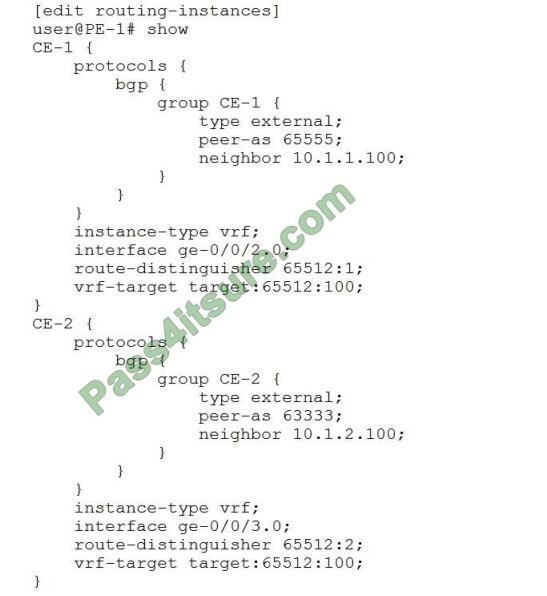
Two CE devices (CE-1 and CE-2) belong to the same customer and connect into a single PE device (PE1). However,
the CE devices cannot communicate with each other. You want to allow the CE devices to communicate with each
other. Referring to the exhibit, which action would solve the problem?
A. Configure both routing instances with the set routing-options autonomous-system loops 3 statement.
B. Configure both routing instances with the as-override statement within the BGP protocol.
C. Configure both routing instances with the vrf-table-label statement.
D. Configure both routing instances with the set routing-options auto-export statement.
Correct Answer: D
3.
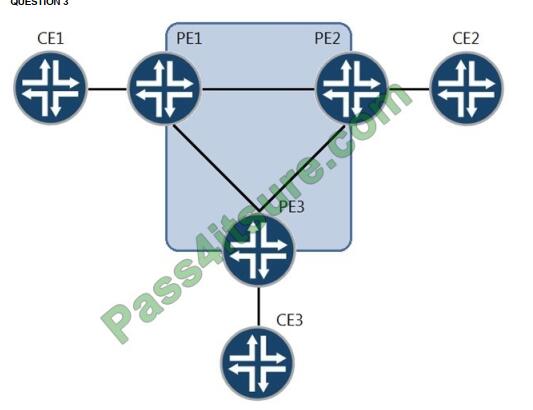
You are provisioning Layer 2 circuits between sites CE1, CE2, and CE3. Referring to the exhibit, which statement is true?
A. A point-to-multipoint LSP must be created between sites.
B. Each site must have only one VLAN configured to the PE.
C. Site PE1 must have a point-to-multipoint link configured towards the core.
D. Two VLANs must be configured from PE 1 to CE 1.
Correct Answer: D
4.
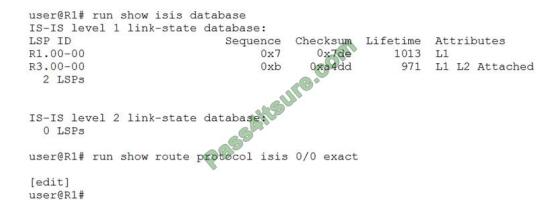
You are troubleshooting an issue where R1 is no longer receiving the default IS-IS route from R3. Referring to the
exhibit, which action would you take to solve the problem?
A. Delete the protocols isis ignore-attached-bit configuration statement on R1.
B. Delete the protocols isis level 2 disable configuration statement on R3.
C. Delete the protocols isis import configuration statement on R1.
D. Delete the protocols isis ignore-attached-bit configuration statement on R3.
Correct Answer: A
5.
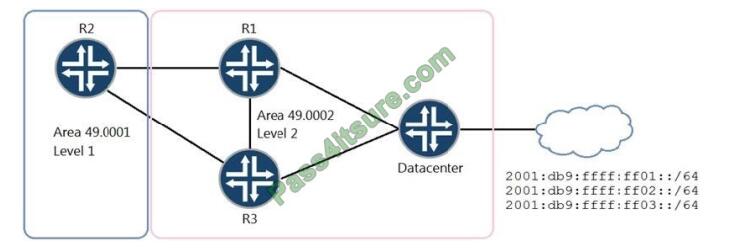
A network designer wants to ensure that traffic from R2 destined for 2001:db9:ffff:ff00::/62 always traverses the R2-R1
link if that link is available. Referring to the exhibit, which configuration change will satisfy this requirement?
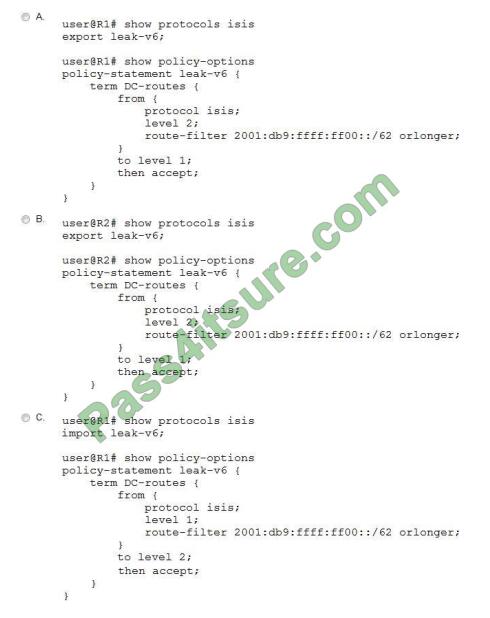
A. Option A
B. Option B
C. Option C
Correct Answer: A
6.
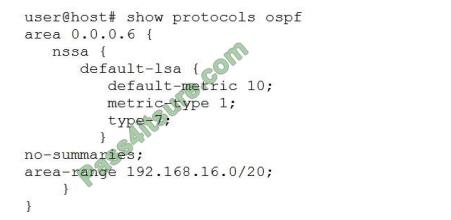
Referring to the ABR configuration shown in the exhibit, which three statements are correct? (Choose three.)
A. The ABR advertises a default route to the NSSA using a Type 7 LSA.
B. The ABR advertises a single Type 3 summary LSA to the backbone area for all Type 1 and Type 2 LSAs in the
192.168.16.0/20 range.
C. The ABR advertises a Type 5 external LSA to the backbone area for each Type 7 LSA in the NSSA.
D. The ABR does not summarize any routes within the 192.168.16.0/20 range.
E. The ABR advertises a single Type 5 external LSA to the backbone area for all Type 7 LSAs in the NSSA.
Correct Answer: ABC
7.
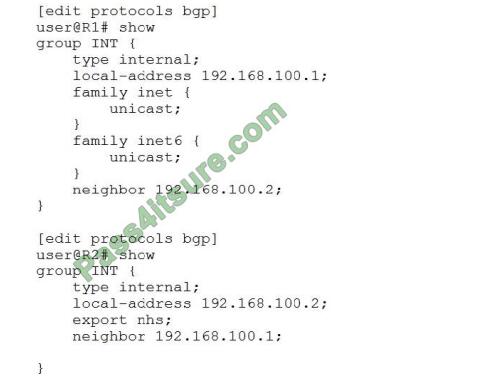
Referring to the exhibit, which statement is true?
A. The BGP session between R1 and R2 will establish correctly and only the inet6 unicast NLRI will pass routing
information.
B. The BGP session between R1 and R2 will fail to establish correctly due to an NLRI mismatch.
C. The BGP session between R1 and R2 will establish correctly and the inet unicast and the inet6 unicast NLRIs will
pass routing information.
D. The BGP session between R1 and R2 will establish correctly and only the inet unicast NLRI will pass routing
information.
Correct Answer: D
8.
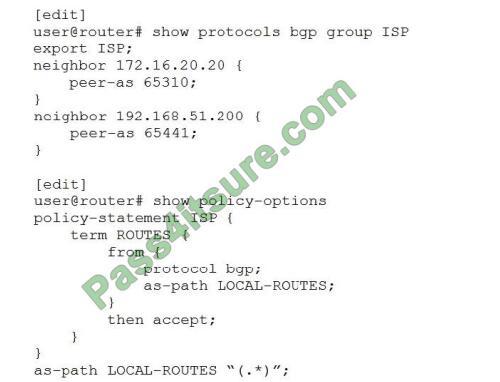
Your network is connected to two different ISPs and you notice that they are using your network for transit traffic.
In this scenario, which two configuration statements will solve this problem? (Choose two.)
A. set policy-options policy-statement ISP term REST then reject
B. set policy-options policy-statement ISP term ROUTES then reject
C. set policy-options as-path LOCAL-ROUTES “()”
D. set policy-options as-path LOCAL-ROUTES “(65310|65441)+”
Correct Answer: AC
9.
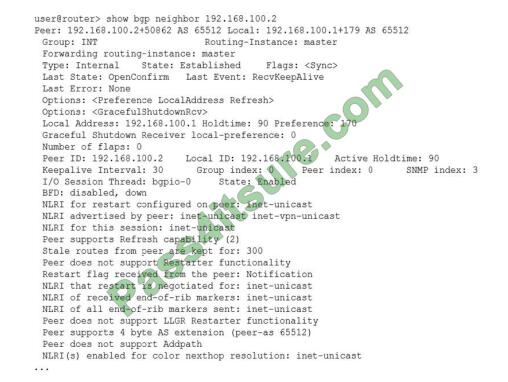
Referring to the exhibit, the local BGP router is receiving IPv4 routes from the BGP neighbor, but it is not receiving L3
VPN routes from the BGP neighbor. Which two actions should you take to solve this problem? (Choose two.)
A. Configure the family inet-vpn unicast statement on the BGP neighbor.
B. Configure the family inet unicast statement on the local BGP router.
C. Configure the family inet-vpn unicast statement on the local BGP router.
D. Configure the family inet unicast statement on the BGP neighbor.
Correct Answer: AC
10.
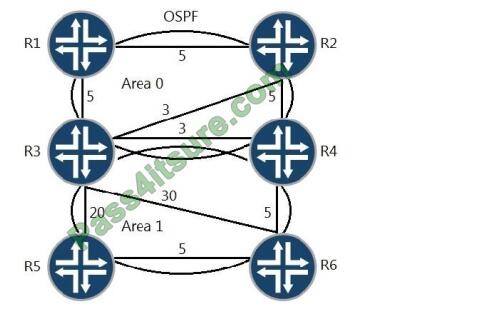
Referring to the exhibit, which path would traffic passing through R1 take to get to R6?
A. R1 -> R2 -> R4 -> R6
B. R1 -> R2 -> R3 -> R6
C. R1 -> R3 -> R5 -> R6
D. R1 -> R3 -> R4 -> R6
Correct Answer: C
11.

You have the LDP signaled VPLS topology as shown in the exhibit. CE-B at Site-2 is multihomed to both PE-2 and
PE-3. In this scenario, where would you configure loop prevention?
A. PE-1
B. CE-B
C. PE-3
D. PE-2
Correct Answer: A
12. A customer recently migrated to IS-IS and is concerned about resource starvation when the routing protocol daemon (RPD) starts. To resolve this issue and protect R2 and R3, which feature should you implement?
A. Double the policy-options damping half-life timer to let the network settle.
B. Implement the overload bit and timer to signal service availability.
C. Deploy firewall filters to limit the prefix count in the route table.
D. Use the forwarding-options ip-options-protocol-queue parameter to increase resources.
Correct Answer: B
13.
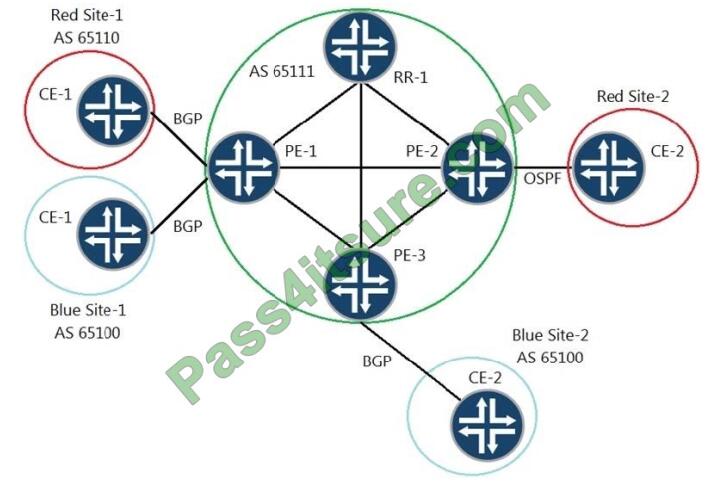
You have a Layer 3 VPN established between PE-1 and PE-2 as well as between PE-1 and PE-3. You are using a route
reflector (RR-1) to distribute VPN routes to your IBGP peers. You are asked to ensure that only relevant routes are sent
from RR-1 to each of the PE routers. Referring to the exhibit, which statement is correct?
A. You should use VRF export policies on RR-1 to control which routes are sent to each PE router.
B. You should use route target filtering only on RR-1 to control which routes are sent to each PE router.
C. You should use firewall filtering on RR-1 and all the PE devices to control which routes are sent to each PE router.
D. You should use route target filtering on RR-1 and all the PE devices to control which routes are sent to each PE
router.
Correct Answer: B
For more JN0-663 questions, this website.